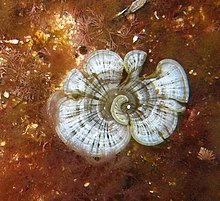
Fucus vesiculosus, known by the common names bladderwrack, black tang, rockweed, sea grapes, bladder fucus, sea oak, cut weed, dyers fucus, red fucus and rock wrack, is a seaweed found on the coasts of the North Sea, the western Baltic Sea and the Atlantic and Pacific Oceans. It was the original source of iodine, discovered in 1811, and was used extensively to treat goitre, a swelling of the thyroid gland related to iodine deficiency.

Fucus serratus is a seaweed of the north Atlantic Ocean, known as toothed wrack, serrated wrack, or saw rack.

Gastroclonium reflexum is a small red alga (Rhodophyta) reported from Ireland and Britain.

Penicillus capitatus is a species of macroalgae, seaweed, that is part of the Udoteaceae, a larger family of algae. The P. Capitatus is a member of green macroalgae, Chlorophyta, so they share some similarities to their terrestrial counterparts. Due to their distinct shape, the Penicillus genus can be referred to as Brush Seaweed, Shaving Brush, or the Mermaid's Shaving Brush.

Halimeda tuna is a species of calcareous green seaweed in the order Bryopsidales. It is found on reefs in the Atlantic Ocean, the Indo-Pacific region and the Mediterranean Sea. Halimeda tuna is the type species of the genus Halimeda and the type locality is the Mediterranean Sea. The specific name "tuna" comes from the Taíno language, meaning "cactus" and referring to the resemblance of the thallus to the growth form of an Opuntia cactus.
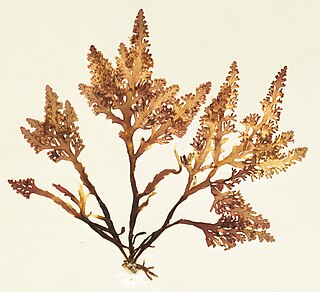
Osmundea pinnatifida is a species of red alga known by the common name pepper dulse.

Ahnfeltia plicata, the landlady's wig, is a species of red alga in the family Ahnfeltiaceae. It grows in northern parts of the Atlantic Ocean.

Cordylecladia erecta is a species of red algae in the family Rhodymeniaceae. It is found in the north east Atlantic Ocean and the Mediterranean Sea and is the type species of the genus.
Lobophora variegata is a species of small thalloid brown alga which grows intertidally or in shallow water in tropical and warm temperate seas. It has three basic forms, being sometimes ruffled, sometimes reclining and sometimes encrusting, and each form is typically found in a different habitat. This seaweed occurs worldwide. It is the type species of the genus Lobophora, the type locality being the Antilles in the West Indies.
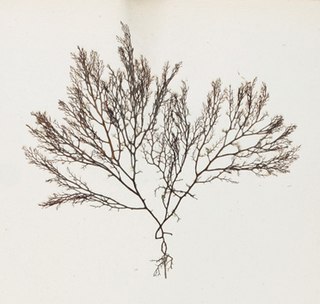
Vertebrata fruticulosa(Boergeseniella fruticulosa Kylin) is a small marine alga in the Division Rhodophyta.

Phyllophora crispa is a medium-sized fleshy, marine red alga. This alga forms dense mats of up to 15 cm thickness, which influence environmental factors, thus creating habitat for several associated organisms.

Padina boergesenii, commonly known as the leafy rolled-blade alga, is a species of small brown alga found in the tropical and subtropical western Atlantic Ocean, the Mediterranean Sea, and the Pacific Ocean. This seaweed was named in honour of the Danish botanist and phycologist Frederik Børgesen.
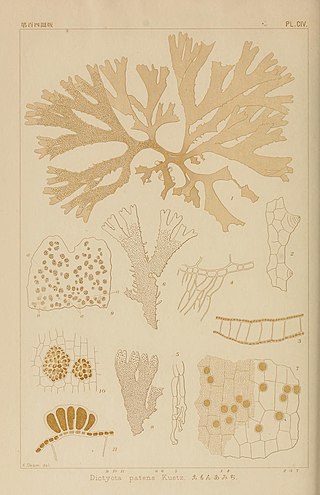
Dictyota bartayresiana, commonly known as a forded sea tumbleweed, is a species of brown alga found in the tropical western Indo-Pacific region and the Gulf of Mexico. It contains chemicals that are being researched for possible use as antimicrobials, as larvicides and as cytotoxins.
Zanardinia is a monotypic genus of seaweed in the brown algae. The only species, Zanardinia typus, commonly known as penny weed, is native to the northeastern Atlantic Ocean and the Mediterranean Sea.
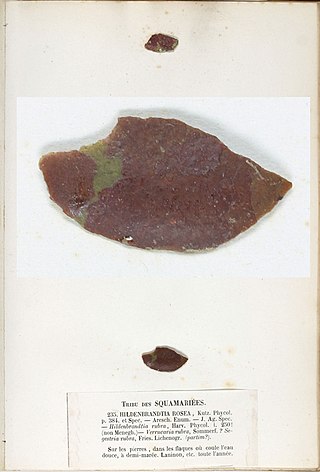
Hildenbrandia rubra is a marine species of thalloid red alga. It forms thin reddish crusts on rocks and pebbles in the intertidal zone and the shallow subtidal zone. It is a common species with a cosmopolitan distribution, and is able to tolerate a wide range of conditions.
Chylocladia verticillata is a medium-sized red marine alga.
Dictyota implexa is a species of brown alga found in the temperate eastern Atlantic Ocean and the Mediterranean Sea.

Dictyota dichotoma is a species of Brown algae found in the temperate western and eastern Atlantic Ocean, the Mediterranean Sea, the Black Sea, the Red Sea and the western Indian Ocean.
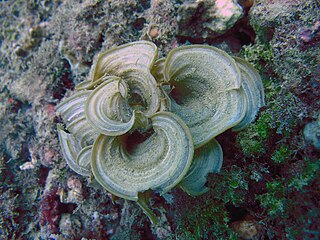
Padina is a genus of brown macroalgae in the family Dictyotaceae.
Padina sanctae-crucis is a species of brown macroalgae in the family Dictyotaceae. It is a tropical brown algae species native to the south pacific that belongs to the Padina genus. this alga includes sexual reproduction and spore-producing asexual reproduction which is moved with the tide until spores plants itself on a hard rocky substrate. Other habitats include rocks and shell fragments in the shallow sublittoral, seagrass meadows, mangrove roots and coral reefs on tidal flats.
